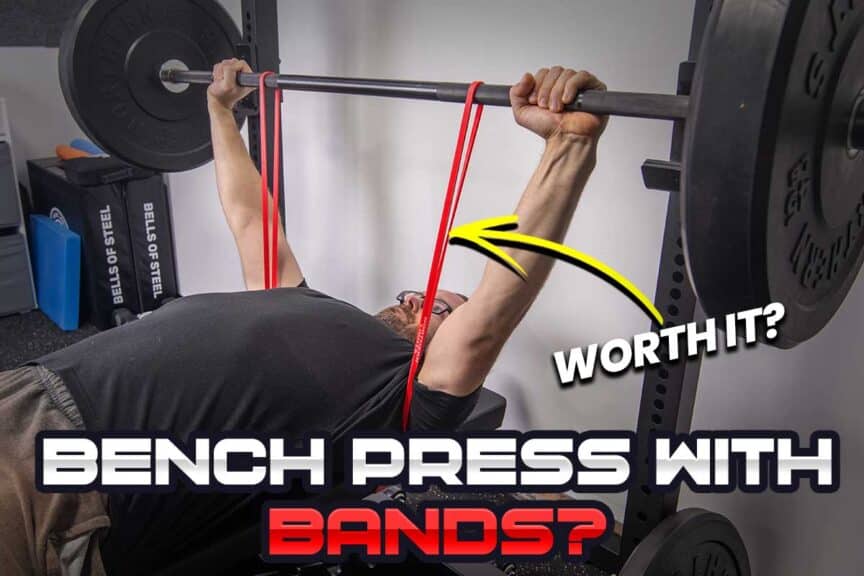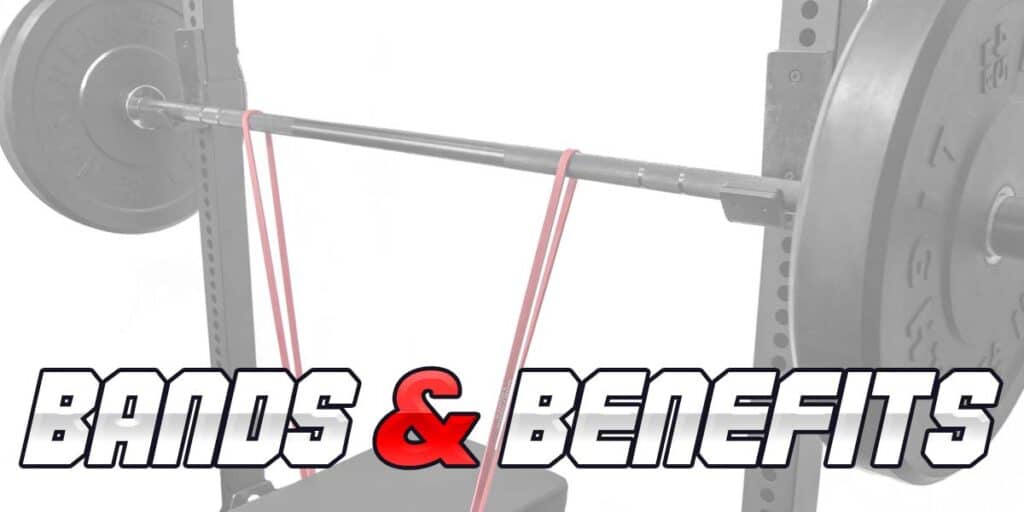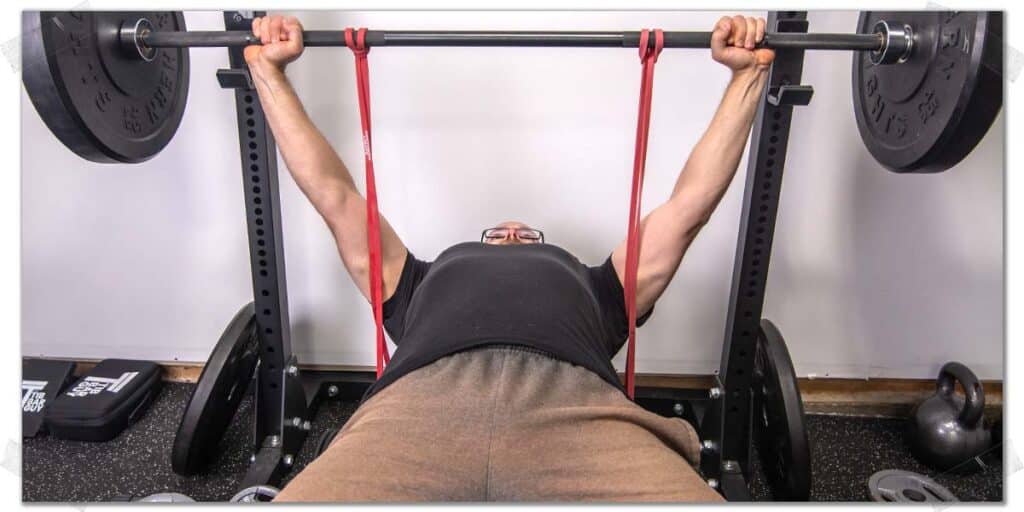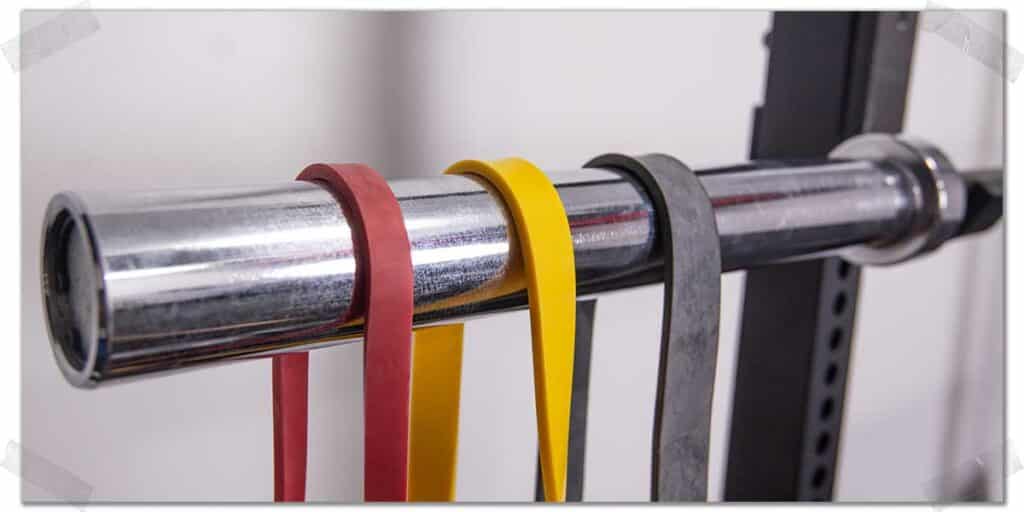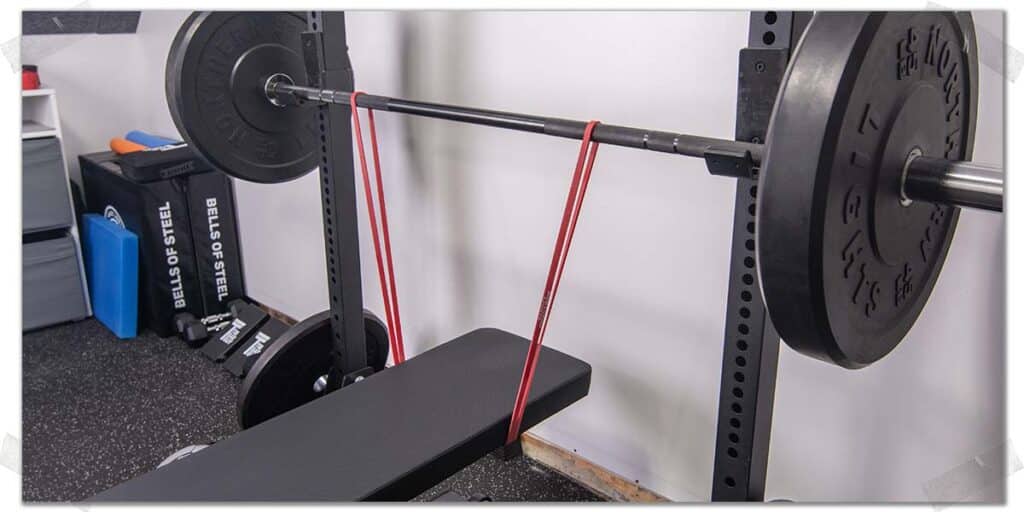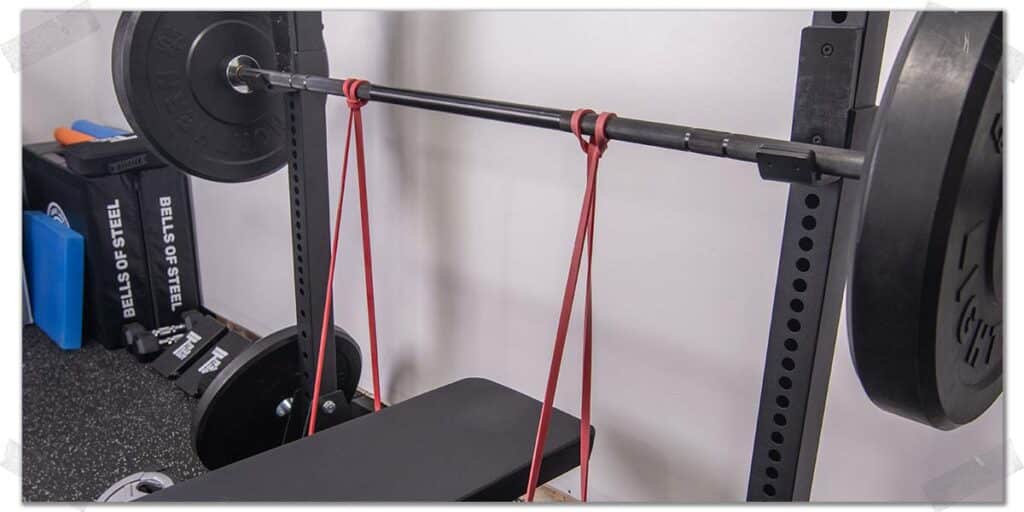When it comes to the bench press, there’s no shortage of ways in which the exercise can be performed, and lifters of all types — be they competitive or recreational — are always looking for ways to increase their bench press and optimize their training to ensure they’re getting as strong as possible.
Adding a resistance band to the barbell is one of those ways. But is this modification worth it, or is it even necessary for increasing your bench press abilities? If so, how do you do it?
In this article, I’ll break down all these topics and provide the answers in clear, meaningful ways. You’ll learn all about what the pros are saying about this training technique, its purpose, the benefits and drawbacks that should be considered, and the best practices if you choose to incorporate it into your bench press training.
So, let’s dive right into it!
A small request: If you find this article to be helpful, or you appreciate any of the content on my site, please consider sharing it on social media and with your friends to help spread the word—it’s truly appreciated!
Accommodating resistance: Bench pressing with bands
While performing any type of bench press (barbell, dumbbell, incline, decline, etc.) provides resistance to your pectoral muscles, anterior deltoid (front shoulder) fibers, and your triceps, each bench press variation has a universal similarity: the resistance or load that you’re lifting stays static (the same) throughout the entire movement with each repetition (i.e., you’re pressing against 200 pounds at all times).
Placing a resistance band around the barbell changes all of this, creating what’s called an accommodating or dynamic resistance. It is also referred to as variable resistance.
Whichever term you use, this ultimately means that the amount of resistance you push against when pressing the weight off your chest changes or accommodates throughout the movement — the further up you press the weight, the more the band stretches, increasing the effort your pectoral, triceps, and shoulder muscles must exert in the process to overcome the resistance.
Top-level bench press coaches will extensively break this concept down and discuss how it alters the overall force curve generated during the exercise. I’m not going to get into such scientific details within this article, but if you would like to read up on this premise a bit more, my buddy Avi has written about it on his website at powerliftingtechnique.com.
Pro tip: The premise behind using bands when benching is very similar to using chains, which are often attached to the sleeves of a barbell and used by high-level powerlifters for their bench press training. So, if you see people bench pressing with chains on the bar (which touch the floor), they’re doing so for essentially the same reasons.
Benefits: using resistance bands when bench pressing
Why use resistance bands when you perform the bench press? Isn’t using heavier resistance enough? In short, sticking with the traditional bench press (i.e., not using bands) is typically enough for most individuals’ needs. Still, accommodating or dynamic resistance does offer a few unique benefits that might be beneficial for certain lifters, notably competitive powerlifters.
Benefit 1: Improved lockout strength
Since resistance bands increase the amount of muscular effort required the further you press the bar upwards, the most significant amount of resistance will be incurred at the top of the press.
This final phase of the lift, where the elbows undergo the final 20 degrees (approximately) of straightening, requires the triceps muscles to perform their greatest contribution to the lift relative to any other point throughout the movement.
As such, bands serve as a helpful way to improve a lifter’s lockout strength, the portion of the lift where the elbows move into their final, straight, or locked-out position.
Training specifically for improving lockout strength is a big deal to competitive powerlifters and bench-only competitors since they must demonstrate a clear lockout on their press for the lift to be counted as acceptable by the onlooking judges.
It can also help them get through their “sticking point” in the lift, which is the phase of the press where the lifter struggles the most to keep pressing the weight (every lifter can have a different sticking point).
Pro tip: While having someone spot you during any bench press exercise is a good idea, having a spotter when performing banded bench press is essential, especially if you have never attempted this bench press variation before! If things go wrong, they can go wrong quickly, leading to potential issues.
Benefit 2: Added eccentric resistance
Since we’re dealing with elastic energy stored within the resistance band, and since the greatest stretch in the band occurs when the arms are straight, the band will want to act as a bit of a slingshot in terms of rapidly pulling the bar down to the lifter’s chest.
Unlike the upward phase of the press (known as the concentric phase), where the resistance becomes greater, the opposite is true when the bar moves closer to the chest; the resistance decreases the closer the bar moves to the chest.
Related article: Eccentric Push-ups: How to Build Upper Body Strength for Beginners
And since we don’t want the bar to be rapidly slingshotted down to the chest, the muscles involved in the bench press must work to prevent this movement from being sudden and quick.
When muscles must lengthen in a controlled manner, such as the pectoral muscles, triceps, and anterior deltoid muscle fibers when lowering the barbell to the chest, it’s known as an eccentric muscle contraction.
Naturally, the greatest extent of eccentric muscle work comes at the start of the downward portion of the lift (where tension on the band is the greatest). This means that the triceps will take the brunt of the added eccentric load coming from the bar.
As such, some lifters opt to use bands when bench pressing not only for added lockout strength but also for added eccentric overload to the triceps as well.
Benefit 3: Improved bar path control
As I’ll mention in further detail in one of the upcoming sections, there is a world of technique involved with bench press, which is important since sound technique not only helps a lifter bench press more weight but also keeps them safe and injury-free.
Bar path —which is exactly what it sounds like — refers to the path the barbell takes on the upward and downward phases of the bench press movement. The ability to produce a consistent, ideal bar path is a fundamental requirement for any bench presser who takes their lifting seriously.
Producing and maintaining optimal bar path under heavy load is incredibly challenging for those who haven’t practiced bench pressing for a number of years.
RELATED CONTENT:
Throw a resistance band into the equation, and bar control gets taken to a new level since a resistance band pulls the barbell directly in line with the band, which may not align with your desired bar path.
When this happens, you will need to devote some serious effort to overcoming the band’s path of pull to ensure you keep the bar directly where you want it to be. In other words, you’ll need to control the bar and band rather than letting them control you.
As such, bands can be helpful for improving your bar control when pressing and lowering the weight.
Target audience: Who should bench press with bands?
Using accommodating resistance of any type (bands or chains) isn’t recommended for beginners or those who have poor bench press technique. This isn’t just my personal insight but also that of the top bench press athletes and coaches on the planet. There are a couple of reasons for this.
Reason 1: Accommodating resistance isn’t a magic pill
Throwing a band around the bar and banging out a few repetitions on your bench press isn’t going to produce any notable strength improvements for how much you can bench when compared to training with a traditional static load (i.e., not using bands). Nor is it likely to increase muscle size to a more significant extent.
Pro tip: If you’re keen on growing your triceps or improving their strength for the bench press, simply opt for benching with a slightly narrower grip, which will target your triceps much more significantly than with a traditional grip width.
It may look cool or provide some added training variety, but the top competitive powerlifters and bench pressers whom I’ve been fortunate enough to train with and get to know all built their 500+ pound bench presses with minimal use of resistance bands in the process.
To quote one of those lifters, “don’t even worry about putting chains or bands on the bar until you can bench press double your body weight.”
Whether you agree or not with that statement is up to you, but seeing how those particular bench pressers have medaled on the world stage for competitive bench press, I’m inclined to take their advice rather seriously.
Reason 2: Accommodating resistance requires very solid bench press technique
Despite what the average individual or gym-goer might think, bench press has a world of technique in it altogether.
Solid bench press technique (setup, maintaining ideal bar path, staying tight, etc.) is essential for any lifter or athlete who wants to increase their bench press and stay safe and injury-free in the process.
Depending on the bench press technique standards you hold yourself to (mine are high, along with my world-ranked bench press friends whom I’m grateful to know), attaining solid bench press technique while pressing relatively heavy loads takes years to achieve.
Throwing a band around the barbell and then trying to maintain perfect technique can bring a whole new world of challenges to the bench press movement, which won’t offer much-added benefit for lifters who are not already highly proficient with bench press.
In short: the potential performance gains one might get by using resistance bands can largely be offset by the added control complexity of the exercise that is then required. Plus, bands can be a bit of a nuisance to set up at times.
How to: Setting up for resistance band bench press
There are two ways in which resistance bands can be utilized for bench press. Let’s start with the more common method (which is more simple to implement and more practical). Then, I’ll show you a lesser-implemented alternative method.
Method 1: Using a single band
This is the most common and straightforward method that most lifters use since it seems to work best and tends to be more convenient than any other method.
- Before you load up the barbell with any plates, you’ll need to loop the band around the barbell’s end (see photo) and have one end of the band resting on the bar itself.
- Pull the band underneath the bench, and slide the free end of the band around the other end of the barbell (you will likely need to have that particular end of the barbell resting on the floor.
- Set the bar on the rack with each end of the band on the inside of where your hands will grab the bar when performing the press.
Pro tip: If you have a barbell with a rather aggressive knurling, you may want to have some small hand towels or similar fabric between the bar and the band since aggressive knurling can chew up your bands rather quickly. Fat Gripz on the bar can also work great for this.
Method 2: Using two bands (the “choke” method)
The dual-band setup isn’t as common (or convenient) as the single-band method. Still, since some lifters do use it, it’s worth briefly going over. The main factor to be aware of here is that you’ll need heavy dumbbells (or kettlebells) that can keep each band anchored to the floor.
- Throw one end of the band around the bar handle and loop the other end through the band, creating a “choke” point on the bar. Do this on both sides.
- Lift one end of the heavy dumbbell (which is directly beneath the band) and lift it so that you can place the band underneath (see photo). Do this on both sides.
This method can make it a bit harder to implement ideal band resistance since you’ll likely have more slack on the bottom end of your bench press than with method 1, but this might be preferred for some lifters.
How strong of a resistance band should you use?
If you’ve decided that bench pressing with resistance bands is appropriate for your training needs, you’ll need to ensure you’re selecting a band that offers an ideal amount of resistance throughout the exercise.
Selecting the ideal band resistance isn’t a perfect science, which is even admitted in some of the research articles I’ve come across on resistance training with bands. So, this will undoubtedly take some trial and error.
What follows below are some rough guidelines to consider:
- Aim for bench pressing around 70-80% of your normal training load (not 70-80% of your maximal lift), with the remaining 20-30% of resistance being generated by the band. This means if your normal working load was 100 lbs, you would do 70-80 lbs between the bar and plates while having the remaining 20-30 lbs come from the resistance band.
- You likely won’t need a band any thicker than 1.5 inches at most. I almost always use a half-inch band or sometimes a 1-inch band. Trust me, this should work just fine for most lifters.
- The more resistance that is generated from the band, the harder it will be to control the bar. The goal is to only have a small portion of the resistance come from the band, not the majority of it.
What does the research say about using bands for bench press?
Anytime a specific training technique is being implemented, it’s worth taking a look to see if there is any scientific support or research that has been done to back up its intended use.
When it comes to using bands to improve bench press performance, research has found:
- Incorporating variable (i.e. accommodating) resistance can help improve overall strength and power gains in lifters and athletes when properly implemented into a periodized training regimen.1
- Utilizing 15% band tension and 85% free weight tension produced notable strength improvements in college-aged men compared to those who only used free weight resistance alone during the bench press.2
- Implementing a 21% resistance band tension with 79% free weight tension was effective for improving bench press performance in rugby players over those who only used free weight resistance.3
Practical considerations
So, the research is clear that resistance bands can certainly help increase your bench press — you can’t argue with the results. But the other question to ask is one of practicality. Are bands practical or necessary for building a stronger bench press?
For the average lifter, likely not. First, there’s the issue of practicality; always having a resistance band on hand and hooking it up to a barbell every time you hop under the bench can be a bit of a nuisance.
More importantly, though, most average gym goers (and even dedicated athletes) would do well to focus on the bigger picture — increasing their strength through optimal training loads, volume, diet, ideal training regimens, and YEARS of refining their bench press technique under light, medium, and heavy loads.
If you’re interested, you’ll find many helpful tips, similar to what I’ve just mentioned above in my article: Becoming the Best Athlete Possible: 50 Proven Tips and Strategies, which covers smart training and effective training concepts in-depth!
To be clear, I’m certainly not against the use of bands for bench pressing. Rather, I believe they need to be implemented strategically and on those who can truly get the most out of them, which isn’t a beginner or those with poor bench press technique.
Remember, tens of thousands of people have built powerful and impressive bench presses (i.e., more than 400 pounds) for decades, all without the use of bands.
Final thoughts
Using a resistance band to increase your bench press can have its benefits for a select group of individuals, but it’s certainly not an approach that is appropriate for every lifter; its potential benefits can easily be offset by the added complexity it brings into the execution of the lift and the overall training session itself.
If you are going to perform your bench press with a resistance band, make sure your technique is absolutely on point, that you have a spotter, and that you’ve built up a solid baseline of strength. Bands can be helpful, but they’re certainly not necessary for building a bigger chest and a stronger bench press.
Frequently Asked Questions
Any time people start performing bench press with resistance bands, plenty of questions are bound to arise. As such, I’ve included a few brief answers below that lifters, athletes, and other gym-goers often have when it comes to this seemingly novel bench press variation. I hope they are of benefit to you!
References:
1. Joy JM, Lowery RP, Oliveira de Souza E, Wilson JM. Elastic bands as a component of periodized resistance training. J Strength Cond Res. 2016;30(8):2100-2106.
2. Bellar DM, Muller MD, Barkley JE, et al. The effects of combined elastic-and free-weight tension vs. free-weight tension on one-repetition maximum strength in the bench press. J Strength Cond Res. 2011;25(2):459-463.
3. García-López D, Hernández-Sánchez S, Martín E, Marín PJ, Zarzosa F, Herrero AJ. Free-weight augmentation with elastic bands improves bench press kinematics in professional rugby players. J Strength Cond Res. 2016;30(9):2493-2499.

Hi! I’m Jim Wittstrom, PT, DPT, CSCS, Pn1.
I am a physical therapist who is passionate about all things pertaining to strength & conditioning, human movement, injury prevention and rehabilitation. I created StrengthResurgence.com in order to help others become stronger and healthier. I also love helping aspiring students and therapists fulfill their dreams of becoming successful in school and within their clinical PT practice. Thanks for checking out my site!

